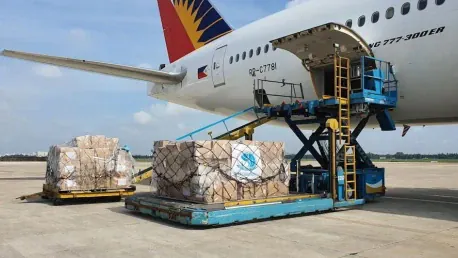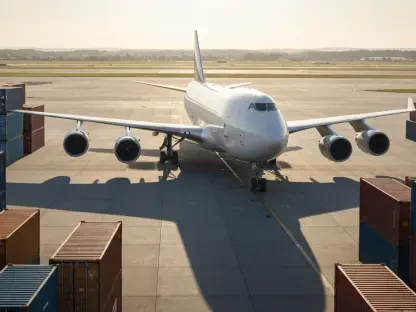The global air cargo market is poised for significant growth in 2025, with projections indicating an increase of 4% to 6%. This anticipated growth surpasses the expected global cargo capacity supply growth of 3% to 4%. Several dynamic factors contribute to this optimistic outlook, including disruptions in ocean supply chains, a resurgence in the traditional air cargo market, and the robust growth trajectory of e-commerce. Sustained growth in the global economy and specific industry trends further boost the potential for expansion, making the landscape of air cargo increasingly complex yet promising.
Economic Indicators and Market Dynamics
Sustained global GDP growth is a crucial driver for the air cargo market. The International Monetary Fund predicts that global GDP will remain stable at 3.2% in 2025, consistent with the projection for 2024. This stability supports the demand for air cargo, as economic growth typically correlates with increased trade and transportation needs. Economic expansion fosters higher production and consumption, leading to a greater need for the swift movement of goods. This direct correlation positions air cargo as a vital component of global trade infrastructure.
A resurgence in the traditional air cargo market is another significant trend witnessing steep improvements. Disruptions in ocean supply chains have led to a shift towards air freight, which offers faster and more reliable transportation options. Industries that demand timely delivery, such as the semiconductor and high-tech sectors, prefer air freight to mitigate potential delays in production schedules. Furthermore, strategic capacity reallocations and the formation of long-term contracts allow stakeholders to adapt to evolving market conditions efficiently, bolstering the overall market resilience.
The Role of the Semiconductor Industry
The semiconductor industry plays a pivotal role in driving air cargo demand. Semiconductors are essential components in modern electronics, and their production and distribution heavily rely on air freight. Projections indicate a 10% rise in global shipments of silicon wafers in 2025, following a 2% decline in 2024. This increase is primarily driven by the growing demand for generative artificial intelligence and advanced computer processing. As technology continues to evolve, the rapid delivery of semiconductor materials becomes increasingly critical, further stressing the significance of air freight in maintaining technological advancements and supply chain efficiency.
Asia, a major hub for semiconductor manufacturing, is expected to see a significant uptick in air cargo volumes. The region’s dominance in the semiconductor market means that a substantial portion of these shipments will be transported via air, contributing to the anticipated surge in the global air cargo market. With countries like Taiwan, South Korea, and China leading the charge in semiconductor production, air freight services will become increasingly indispensable. This geographical concentration underscores Asia’s pivotal role in the broader air cargo ecosystem, shaping global supply chains and facilitating technological progression.
E-commerce Growth and Its Impact
E-commerce continues to be a crucial driver for the air cargo market. The US Department of Commerce estimates a 14% annual growth rate in global B2C and B2B e-commerce until 2026. This growth is particularly pronounced in South Asia and Southeast Asia, regions that are expected to lead the e-commerce boom. The convenience and efficiency of online shopping foster increased demand for quick delivery services, positioning air cargo as a backbone for the e-commerce sector. The burgeoning middle class and rising internet penetration in these regions amplify the demand for a robust air freight infrastructure to support the expanding e-commerce ecosystem.
However, regulatory scrutiny poses potential challenges to e-commerce growth. The European Union is investigating Chinese e-commerce platforms like Temu, which could result in significant fines or bans. Indonesia has already banned Temu, reflecting concerns over the impact on local small and medium enterprises. In the US, increased customs scrutiny and proposed legislation to close loopholes allowing Chinese e-commerce goods to enter without import duties could also affect e-commerce volumes. These regulatory measures aim to protect local markets but could inadvertently slow down air cargo traffic, necessitating adaptive strategies from stakeholders to navigate such policies effectively.
Regulatory and Political Uncertainties
Political interventions, such as increased tariffs on imports from China, could dampen e-commerce volumes and impact the air cargo market. The US might recalibrate capacity and demand balances on critical trade corridors if such measures affect trade volumes. Adaptability to political shifts is essential, as fluctuations in trade policies directly influence cargo routes, volumes, and overall market dynamics. Stakeholders must remain agile, reevaluating strategies to maintain efficiency and cost-effectiveness while mitigating potential disruptions caused by geopolitical developments.
The traditional air cargo market may find solace in these uncertainties, creating opportunities for growth amidst e-commerce regulatory challenges. Strategic capacity allocations and securing longer-term contracts can help mitigate the impact of regulatory and political uncertainties. By focusing on long-term agreements and strategic partnerships, companies can ensure stable and predictable operations despite the volatile political landscape. This approach fosters resilience and continuity, allowing the traditional air cargo market to thrive and adapt to regulatory frameworks more effectively.
Air Cargo Market Trends and Repercussions
The year 2024 saw the air cargo market rebalancing from the volatile conditions of previous years. This was supported by strategic capacity allocations, securing longer-term contracts, and better industry preparedness. These measures have steadily stabilized the air cargo market, providing a robust groundwork for 2025 and beyond. Continued reliance on e-commerce is evident, even as general freight markets remain muted, notably in Europe. E-commerce continues to fill the slack in demand caused by dips in manufacturing, ensuring that air cargo remains a viable and necessary option despite fluctuating traditional freight markets.
As stakeholders rely less on historical trends for purchasing decisions, market volatility remains high. Embracing flexible freight rate negotiation methods like indexing or transparent pricing is recommended. Such strategies help mitigate risks associated with market unpredictability, ensuring more stable and predictable operations. The US East Coast port strike threat raises concerns for potential disruptions in global ocean freight, driving spikes in air cargo rates and prompting reliance on air freight for urgent shipments. Shippers must remain proactive in managing contracts and tariffs, emphasizing adaptability and contingency planning to navigate potential disruptions effectively.
Geopolitical Tensions and Mode Shifts
Geopolitical tensions, such as the conflict in the Red Sea, have caused significant shifts from ocean to air freight. This trend is expected to continue into 2025, impacting air cargo demand as political instability in key maritime regions forces stakeholders to seek more reliable transport alternatives. Although a return to ocean freight through the Suez Canal seems unlikely soon due to ongoing tensions, this mode shift has significantly influenced air cargo volumes, pushing shippers to prioritize air transport for efficiency and security.
Any resolution leading to a large-scale return of ocean freight traffic could temporarily spike air cargo demand due to congestion at destination ports. Stakeholders must remain vigilant and adaptable to these geopolitical shifts, ensuring they can respond swiftly to changes in transportation modes. This adaptability involves maintaining flexible logistics strategies and investing in diversified transport options to mitigate risks and capitalize on market opportunities. Shifts in geopolitical dynamics emphasize the need for a strategic approach, with a focus on resilience and readiness to tackle unforeseen challenges.
Capacity Constraints and Environmental Regulations
Global air cargo capacity growth reached pre-pandemic levels in early 2023, but demand took until 2024 to recover. The slowdown in capacity growth in 2025 is attributed to several factors, including supply chain issues and manufacturing delays of new aircraft. Companies must plan strategically, optimizing existing resources and investing in innovative technologies to enhance efficiency and sustainability. Environmental regulations could further constrain future growth, compelling stakeholders to adopt eco-friendly practices and comply with stringent standards to minimize environmental impact.
Regulations from the International Civil Aviation Organization taking effect in 2028 will end the production of some current freighter models. These capacity constraints necessitate strategic planning and investment in new and more efficient aircraft models. Future-proofing air cargo fleets involves prioritizing sustainability and leveraging advancements in green technologies to meet regulatory requirements and corporate environmental goals. Adopting sustainable practices not only ensures compliance but also aligns with global trends towards eco-conscious operations, enhancing long-term viability and reputation within the industry.
Security Concerns and Weather Events
The global air cargo market is on track for significant growth through 2025, with projections suggesting an increase between 4% and 6%. This anticipated growth rate notably exceeds the expected global cargo capacity supply growth, which is projected to be between 3% and 4%. Several dynamic factors are driving this optimistic outlook. Disruptions in ocean supply chains are pushing businesses to seek more reliable alternatives, leading to a resurgence in the traditional air cargo market. Additionally, the e-commerce sector is experiencing a robust growth trajectory, further fueling demand for air cargo services.
Sustained growth in the global economy also plays a crucial role, as an expanding economy tends to increase trade volumes, thereby heightening the need for air cargo services. Specific industry trends, such as the rise in just-in-time manufacturing and the adoption of faster delivery standards, are further boosting the air cargo market’s potential for expansion. These combined elements make the landscape of air cargo increasingly complex yet highly promising.
Air cargo carriers and service providers are expected to benefit from these trends, necessitating strategic investments in infrastructure and technology to handle the anticipated growth efficiently. With a multi-faceted growth trajectory that includes a mix of traditional and emerging market drivers, the air cargo market is set for a promising future, reflecting the broad, dynamic shifts in global trade and logistics practices.









